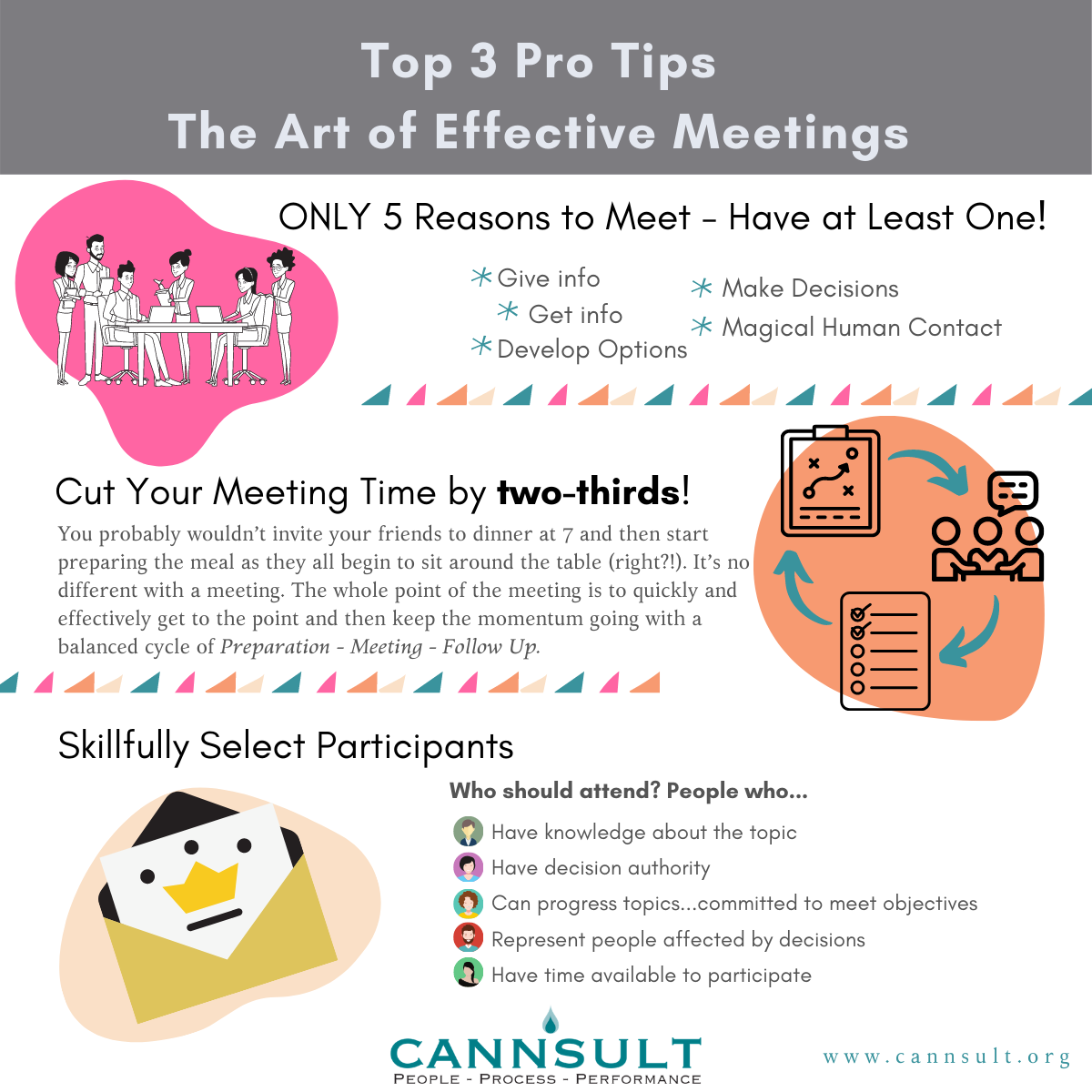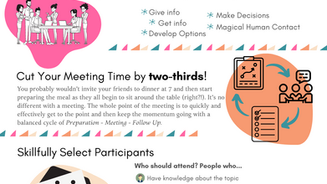
We’ve all been there…
10 am Monday team meeting, you’re the first one there, and to pass the time awkwardly stare at your weekly meeting agenda that’s the same copy-pasted meeting template as every other week. People slowly start to file in, some are on a work call, and some are on their computers still. The person who called the meeting starts talking, and finding that they’re getting no feedback from the participants, they keep talking for the entirety of the meeting. Or if there is discussion, it tends to go in repetitive circles. You’re still wondering why you’re in the meeting. And after an hour, you utter that infamous phrase,
“well this could’ve been an email”.
Meetings should create energy and momentum – they should not suck the life out of you!
Here’s some great info that will prevent you from being the one hosting the horrible meeting!
When you request a meeting, you’re saying that your meeting is important enough to warrant other people’s time – more important than anything else they might need to do at that time. Consider this…every time someone says YES to your meeting, they’re saying NO to something else! So let’s do it. Let’s fix meetings once and for all with a few simple changes!
Pro Tip #1 : ONLY 5 Reasons to Meet – Have at least ONE!
Sure, there are a million different meetings, but there are really only 5 good reasons to meet.
-
Give Info
-
Get Info
-
Develop Options
-
Make Decisions
-
Human Contact
Each may be a perfectly fine reason, and you may have more than one – but make sure you and everyone at your meeting knows and agrees with which of these you are going to accomplish. Here are some examples of openers for each of the 5 reasons.
Give Information
“I’ve brought you all together today to let you know what’s been going on with the new location. I’d like you to leave here today with as much background as you need to be able to answer questions that may arise from our staff and patients.”
Get Information
“We’ve invited you all here to find out what’s going on in your division relative to the new regulations. We want to know what’s happening at all levels in the organization so that we can make some adjustments in our plans accordingly.”
Develop Options
“We’d like to spend this afternoon coming up with as many possible ideas to solve the problem we’ve recently uncovered in the new system. We want to make sure we’ve got everyone’s perspectives and all possible alternatives.”
Make Decisions
“We’ve brought you all together this morning to present to you the three proposed approaches to launching our new telemedicine portal, and get a consensus decision on which one to pursue.”
Human Contact
“There are three items we would like to cover today. And although we could have done this by email, we wanted to have an opportunity to bring the new team together in one place, and get some time to get to know each other between the lines…”
Pro Tip #2; Cut your Meeting time by two-thirds!
You probably wouldn’t invite your friends to dinner at 7 and then start preparing the meal as they all begin to sit around the table. It’s no different from a meeting. One of the most common mistakes in the millions of meetings that occur every day is the lack of effective preparation and follow-up. Instead of prep and follow-up happening before and after the meeting, people expect that it all happens during the meeting. In fact, you should be spending as much time before and after the meeting as you do in the meeting. Instead of a 90-minute bad meeting, spend 30 minutes on Preparation, 30 minutes in the meeting, and then 30 minutes on Follow-Up tasks. The whole point of the meeting is to quickly and effectively get to the point and then keep the momentum going with a balanced cycle of Preparation – Meeting – Follow Up.
Preparation
Bad meetings start before the meeting begins. The whole aim of a meeting is to have max impact with minimal intervention, which indeed requires careful planning. Think of a surgeon; the actual surgery – the physical work – is only a small part of the process. We should approach the running of the business the same way. The time we allow for thinking and planning allows us to operate with surgical precision during times of action. The time you spend preparing for the meeting should be blocked off and deemed just as important as the meeting itself. If you don’t plan well, attendees will sense your lack of prep and interpret that your meetings are not important to you. The prep should include creating a crisp and clear agenda that will clearly drive the team to reach the meeting objective. For every topic on the agenda, determine how the item will be accomplished; what tool or method will be used? For example, if your objective is to develop options, then you might select multiple Advanced Brainstorming Techniques to get the job done. If your objective is to Make Decisions, you might use a simple 2×2 Filter Matrix to weigh your options.
The Actual Meeting
With the meeting plan ready to go, and the objectives clear, it is the job of the person running the meeting to facilitate! As you walk through the agenda, you will monitor progress, focus on deliverables, and track open issues (items that should be addressed, but not during the current meeting). Open issues can be Parking Lot Items or Action Items. Pay attention to behaviors, but don’t intervene until a behavior inhibits team progress, or the discussion is becoming too emotional or personal. Stick to the agenda. And if it’s not working, shift to another method or approach to drive to a successful conclusion.
Follow-up
If it was a productive meeting, the issue or topic was either resolved OR there should be a list of action items with assigned parties and due dates. Take time at the meeting wrap-up to compile these and make sure the team is aligned and prepared to take action. Set doable Due Dates. People almost always overestimate how quickly items can be completed (we can usually count on competing demands on our time) and then they come to the next meeting with tasks incomplete. When this happens, it can thwart your next agenda and suck all the energy out of the next meeting.
Pro Tip #3 ; Skillfully Select Participants
Inviting the right people in the meeting is critical if you are aiming for productive use of everyone’s time. Overcrowded meetings aren’t meetings – that’s group therapy! While meetings can be one way to include people for the sake of gaining buy-in, it’s not always effective, and it shouldn’t be used often. Meeting invitees should be selected based upon these criteria…
-
Topic knowledge
-
Decision authority; Can progress topics
-
Representation from groups affected by decisions
-
Committed to solving the problem
-
Time available to participate
-
Willingness to collaborate
Resist inviting team members that aren’t contributing to the goal of the meeting. For example, you don’t need 2-3 people from the same team. As a rule of thumb, five to seven people is best for most meetings, and 10 is a good number for brainstorming sessions.
Somehow, meetings have gotten out of control and way off track. We never hear people say that we need more meetings! We need fewer meetings, and those meetings need to be efficient and productive. Some meetings should never have been meetings, to begin with. Before scheduling a meeting, consider whether the issue could be addressed by having a conversation. Many unnecessary meetings could be avoided if there was better direct communication. And as a meeting guest, hold the meeting organizer to your standards. If there is no agenda, it’s probably not worth your time! Ask for an agenda and then determine if your presence is necessary. Great meetings – that’s a BIG topic. But you will see a real improvement if you reboot your meetings with these simple 3 tips!
Here’s a freebie lesson that you can use when your meeting is focused on Developing Options (one of the 5 reasons to meet). Don’t settle for the lifeless list of lackluster ideas. Our quick module on Beyond Brainstorming will show you a few simple techniques to boost creativity when you need it!
Check out our online Lean Six Sigma certification courses or, if you’re already certified, try our templates! We’d love to hear your feedback!










